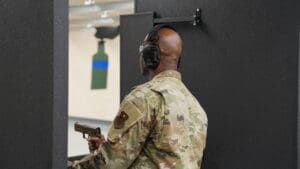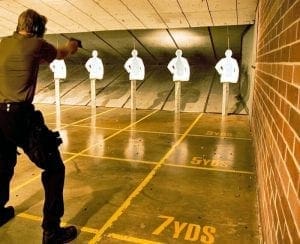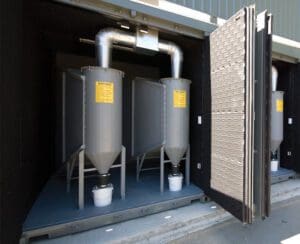Differences Between Static & Tactical Shooting Ranges
Published

Shooting ranges can be broken into two broad categories: static shooting ranges and tactical shooting ranges (also sometimes called “dynamic shooting ranges.”)
Static Shooting Ranges
In a static shooting range, everything stays behind the firing line. Each shooter has their own stall and remains confined to that area, separated from other shooters by a partition. For practical purposes, most modern static shooting ranges will have a target retrieval system, which may be manual or able to move automatically and even follow a pre-programmed course of fire with “shoot/don’t-shoot” pivoting and “flinch faking” movements. Despite those mildly “dynamic” elements, a static range is still a “linear” training environment. It’s fundamentally “static” in that, with a few exceptions, the shooter always stands with their feet planted.

The upside of static ranges is that they are relatively easy for the range master to manage safely: the range master can readily monitor every shooter, and it’s unusual for a loaded firearm to be pointed anywhere other than downrange. By design, all shots are intended to go down range, and that is generally what happens.
The drawback lies in the limitations of a static range, which offers a relatively confined and regimented training environment. Unfortunately, it fails to replicate real-world shooting scenarios and lacks the intellectual engagement crucial for the shooter, leading to less comprehensive training overall.
Tactical Shooting Ranges
A tactical shooting range is substantially different. In a tactical range, the shooter advances downrange as they work through their course of fire, interacting with both stationary obstacles and moving targets. Targets might approach or flee the shooter, cross perpendicular to the shooter’s movement, pop up, or pivot. The shooter’s attention must expand to cover up to 360º, and they need to continuously engage a broader range of cognitive capacities, making split-second shoot/don’t-shoot decisions.
Unsurprisingly, a tactical range is also inherently more difficult for a range master to control and safely manage. The shooter is moving through the space and can point a loaded firearm in any direction at any time. While all shots are still intended to go downrange, it’s clear that there are many opportunities for an errant shot to go wild.
 But there is a substantial upside. Tactical shooting ranges allow for much more dynamic training, encompassing a broader set of skills and a more comprehensive range of real-world shooting conditions.
But there is a substantial upside. Tactical shooting ranges allow for much more dynamic training, encompassing a broader set of skills and a more comprehensive range of real-world shooting conditions.
“You’re in a more fluid environment, where you’re traversing and training tactical maneuvers and reactions,” explains MILO Live project manager Mike Hansen. MILO Live is a leading designer of state-of-the-art shooting range and live-fire training systems—including standard and custom static and tactical shooting ranges—for law enforcement, the military, and private organizations. “You’re using all different kinds of forms in a tactical setting: working around stationary barricades, shooting over something that simulates shooting over a car hood or under a table. You might have laterally moving targets running on a floor or a hanging rail, fixed turning targets, or pop-up targets. It can be an extremely rich training environment.”
MILO Live Tactical Shooting Range Options
MILO Live uses two primary configurations for their custom tactical shooting ranges: the wide-open configuration and a two-lane bay configuration.
As the name implies, wide-open configuration tactical shooting ranges are the most flexible. Any custom range with this configuration can include any style of moving target (laterally moving “running man” targets, fixed turning targets, pop-up targets, etc.), as well as video simulation systems. A wide-open configuration tactical range may feature permanent obstacles and barriers. But it is more common to outfit them with movable barricades. That can be magnetically anchored to the floor, making it possible to quickly create a wide range of obstacles, coverage, and concealment. Because MILO Live’s wide-open configuration tactical ranges do not require dedicated lanes or stalls, they are generally only used primarily for tactical training. Some training facilities will thus maintain a separate, smaller static range for basic lessons, qualifications, and so on.
MILO Live’s two-lane bay configuration, on the other hand, aims to offer the best of both worlds. Each modular two-lane unit can be used either as a pair of static lanes (for fundamentals training, qualification activities, and so on) or as a single wide tactical lane. In “tactical mode,” shooters can progress downrange, interacting with the full range of obstacles and barriers, moving targets, and interactive video simulation systems.
Health, Safety, and Comfort
As is the case with every one of MILO Live’s custom static shooting ranges, any configuration of their standard and custom tactical shooting ranges puts safety and comfort first.
“In a tactical environment,” Hansen explains, “when you’re moving and engaging over, under, and around barricades, it’s easy to have an improperly directed projectile in a tactical range. We use both armor paneling and ballistic containment material on the walls and ceilings. On the off chance that someone discharges a weapon into a wall, ceiling, or obstacle, even at a 90-degree angle, the ballistic absorption materials are there to contain those bullets and greatly reduce the chance the projectile can come back out of that material.”
But safety isn’t just about ballistic safety; range operators and regular range users also need to be careful of the impact of long-term exposure to lead dust and particulate. Additionally, there’s the pressure of being a “good neighbor” to the community where your range is in operation.
MILO Live makes all of that easy:

Lead mitigation is at the core of MILO Live range design. Every indoor range includes integrated vertical “media-free” bullet traps and its own independent HVAC system, with down-range laminar flow and HEPA filters to capture all lead particulate. The tested noise level outside most MILO Live ranges is just 8dB over ambient when firing a 9mm pistol (that’s quieter than a whispered conversation).
Call us today to discuss your needs and allow us to put our expertise to work for you.

